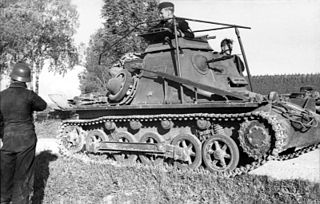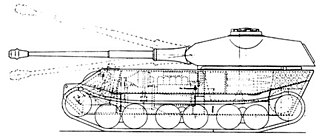 W
WNazi Germany developed numerous tank designs used in World War II. In addition to domestic designs, Germany also used various captured and foreign-built tanks.
 W
WThe Entwicklung series, more commonly known as the E-Series, was a late-World War II attempt by Nazi Germany to produce a standardised series of tank designs. There were to be standard designs in five different weight classes from which several specialised variants were to be developed. This intended to reverse the trend of extremely complex tank designs that had resulted in poor production rates and mechanical unreliability.
 W
WThe Entwicklung series, more commonly known as the E-Series, was a late-World War II attempt by Nazi Germany to produce a standardised series of tank designs. There were to be standard designs in five different weight classes from which several specialised variants were to be developed. This intended to reverse the trend of extremely complex tank designs that had resulted in poor production rates and mechanical unreliability.
 W
WIn the statistical theory of estimation, the German tank problem consists of estimating the maximum of a discrete uniform distribution from sampling without replacement. In simple terms, suppose there exists an unknown number of items which are sequentially numbered from 1 to N. A random sample of these items is taken and their sequence numbers observed; the problem is to estimate N from these observed numbers.
 W
WThe Kugelpanzer is a one-man armoured vehicle built by Germany during World War II. The history of the vehicle is practically unknown other than the fact that at least one example was exported to Japan and used by the Kwantung Army. The machine remains something of a mystery due to the lack of records and the incompleteness of the sole surviving model.
 W
WThe Landkreuzer P. 1000 "Ratte" was a design for a 1000-ton tank to be used by Nazi Germany during World War II which may have been proposed by Krupp director Edward Grotte in June 1942, who had already named it "Landkreuzer". Submitted designs and drawings of the vehicle went under the names OKH Auftrag Nr. 30404 and E-30404/1, which were presented in December 1942. The tank was planned to be 1000 tonnes, being far heavier than the Panzer VIII "Maus", the heaviest tank ever built. The project gained the approval of Adolf Hitler, who had expressed interest in the development of the tank, but was cancelled by Minister of Armaments Albert Speer in early 1943.
 W
WThe Leichttraktor (Vs.Kfz.31) was a German experimental tank designed during the Interwar Period.
 W
WThe VK 16.02 Leopard was a planned German light reconnaissance vehicle designed from mid-1941 through to January 1943, with serial production scheduled for April 1943. It was intended to be the replacement of Panzer II Ausf. L "Luchs". The project was canceled in January 1943 before the first prototype was completed as it did not meet the requirements for 1944.
 W
WThe Panzerkampfwagen II Ausf. L "Luchs" is a German light tank from the Second World War, developed between 1940 and 1942 by Daimler-Benz and MAN. The Luchs was the only Panzer II design with the Schachtellaufwerk overlapping/interleaved road wheels and "slack track" configuration to enter series production, with 100 being built from September 1943 to January 1944 in addition to the conversion of the four Ausf. M tanks. Originally given the experimental designation VK 13.03, it was adopted under the alternate name Panzerspähwagen II and given the popular name Luchs. The Luchs was larger than the Panzer II Ausf. G in most dimensions. With a six speed transmission, it could reach a speed of 60 km/h (37 mph) with a range of 290 km (180 mi). The FuG 12 and FuG Spr radios were installed, while 330 rounds of 20 mm and 2,250 rounds of 7.92 mm ammunition were carried.
 W
WThe German Neubaufahrzeug series of tank prototypes were a first attempt to create a medium tank for the Wehrmacht after Adolf Hitler had come to power. Multi-turreted, heavy and slow, they were not considered successful, which led to only five being produced. These were primarily used for propaganda purposes and training, though three took part in the Battle of Norway in 1940. Pictures of the Neubaufahrzeugs were displayed with different turret models and orientations to fool allied spies; American and Soviet agents independently reported that the Germans had two new heavy tanks, the Panzer V and VI. In reality, these tanks were far from the Panzer V Panther and the Panzer VI Tiger.
 W
WThe Panther II tank was a German tank design proposal, based on the Panther tank during the Second World War. It had slightly thicker armour when compared with the Panther and some standardised components were implemented from the Tiger II tank. The Panther II did not progress beyond prototypes and did not enter production.
 W
WThe Panther is a German medium tank deployed during World War II on the Eastern and Western Fronts in Europe from mid-1943 to the war's end in 1945. It had the ordnance inventory designation of Sd.Kfz. 171. It was designated as the Panzerkampfwagen V Panther until 27 February 1944, when Hitler ordered that the Roman numeral "V" be deleted. Contemporary English-language reports sometimes refer to it as the "Mark V".
 W
WThe Panzerkampfwagen 38(t), originally known as the ČKD LT vz. 38 was a tank designed during the 1930s, which saw extensive service during World War II. Developed in Czechoslovakia by ČKD, the type was adopted by Nazi Germany following the annexation of Czechoslovakia. With the German Army and other Axis forces, the type saw service in the invasions of Poland, France and the USSR. Production ended in 1942, when its main armament was deemed inadequate. In all, over 1,400 Pz. 38(t)s were manufactured. The chassis of the Pz. 38(t) continued to be produced for the Marder III (1942–1944) with some of its components used in the later Jagdpanzer 38 (1944–1945) tank destroyer and its derivative vehicles.
 W
WThe Panzer I was a light tank produced in Nazi Germany in the 1930s. The name is short for the German Panzerkampfwagen I, abbreviated PzKpfw I. The tank's official German ordnance inventory designation was Sd.Kfz. 101.
 W
WThe Panzerkampfwagen I Ausf. C, also known as its prototype name VK 6.01, was a German light tank from the Second World War. Although the Panzer I Ausf. C was formally designated as a modification of the Panzer I, it was actually a completely new vehicle. This variant has little similarity with earlier Ausf. A and B variants - one of the main distinctions being the use of the Schachtellaufwerk inter-leaved track wheels which was used in many later German tanks during the war
 W
WThe Panzerkampfwagen I Ausf. F, also known as VK 18.01, is a German light tank from World War II. Despite the fact that it was designated as a modification of the light tank Panzer I, the VK.18.01 was a completely new vehicle, had almost nothing to do with it. The Pz.Kpfw.I Ausf.F was created in 1942 as a light tank designed to storm fortified lines. In that same year, 30 units were produced. Since 1943 it was used for anti-guerrilla operations on the Eastern Front and in Yugoslavia. Thirty Ausf F tanks were built between April and December 1942, eight of which were sent to the Eastern Front for evaluation.
 W
WThe Panzer II is the common name used for a family of German tanks used in World War II. The official German designation was Panzerkampfwagen II.
 W
WThe Panzerkampfwagen III, commonly known as the Panzer III, was a medium tank developed in the 1930s by Germany, and was used extensively in World War II. The official German ordnance designation was Sd.Kfz. 141. It was intended to fight other armoured fighting vehicles and serve alongside and support the similar Panzer IV, which was originally designed for infantry support. However, as the Germans faced the formidable T-34, more powerful anti-tank guns were needed, and since the Panzer IV had more development potential with a larger turret ring, it was redesigned to mount the long-barrelled 7.5 cm KwK 40 gun. The Panzer III effectively swapped roles with the Panzer IV, as from 1942 the last version of Panzer III mounted the 7.5 cm KwK 37 L/24 that was better suited for infantry support. Production of the Panzer III ceased in 1943. Nevertheless, the Panzer III's capable chassis provided hulls for the Sturmgeschütz III assault gun until the end of the war.
 W
WThe Panzerkampfwagen IV, commonly known as the Panzer IV, was a German medium tank developed in the late 1930s and used extensively during the Second World War. Its ordnance inventory designation was Sd.Kfz. 161.
 W
WThe Panzerkampfwagen VII Löwe (Lion) was a design for a super-heavy tank created by Krupp for the German government during World War II. The project, initially code-named VK 70.01 (K), never left the drawing board, and was dropped on 5–6 March 1942, in favor of Porsche's heavier Panzer VIII Maus.
 W
WPanzerkampfwagen VIII Maus was a German World War II super-heavy tank completed in late 1944. It is the heaviest fully enclosed armored fighting vehicle ever built. Five were ordered, but only two hulls and one turret were completed, the turret being attached, before the testing grounds were captured by advancing Soviet military forces.
 W
WThe Panzerkampfwagen E-100 (TG-01) was a German super-heavy tank design developed towards the end of World War II. The largest of the Entwicklung series of tank designs intended to improve German armored vehicle production through standardization on cheaper, simpler to build vehicles. By the end of the war, the chassis of the prototype E-100 had been partially completed; it was shipped to the United Kingdom for trials, but was later scrapped.
 W
WThe Schmalturm was a tank turret designed for use on the Panther Ausf. F medium tank. There was a Krupp proposal to fit it onto the Panzer IV medium tank as well. The turret's shape resembled the Soviet T-34 tank turret with a narrow conical gun mantlet resembling German Jagdpanzer mantlets. It featured a narrow front to maximize protection while minimizing weight. It was both lighter and easier to manufacture than the standard Panther turret. The turret had a stereoscopic rangefinder with lenses on either side of the turret, located in spherical bulges. No Schmalturms entered series production.
 W
WThe kleiner Panzerbefehlswagen, known also by its ordnance inventory designation Sd.Kfz. 265, was the German Army's first purpose-designed armored command vehicle; a type of armoured fighting vehicle designed to provide a tank unit commander with mobility and communications on the battlefield. A development of the Army's first mass-produced tank, the Panzer I Ausf. A, the Sd.Kfz. 265 saw considerable action during the early years of the war, serving in Panzer units through 1942 and with other formations until late in the war.
 W
WTiger 131 is a German Tiger I heavy tank captured by the British 48th Royal Tank Regiment in Tunisia during World War II. Preserved at The Tank Museum in Bovington in Dorset, England, it is the only operating Tiger I in the world as of early 2021.
 W
WThe Tiger I was a German heavy tank of World War II that operated beginning in 1942 in Africa and in the Soviet Union, usually in independent heavy tank battalions. It gave the German Army its first armoured fighting vehicle that mounted the 8.8 cm KwK 36 gun. 1,347 were built between August 1942 and August 1944. After August 1944, production of the Tiger I was phased out in favour of the Tiger II.
 W
WThe Tiger II is a German heavy tank of the Second World War. The final official German designation was Panzerkampfwagen Tiger Ausf. B, often shortened to Tiger B. The ordnance inventory designation was Sd.Kfz. 182. It was known as King Tiger by Allied soldiers, and is also known under the informal name Königstiger. The name Königstiger was never used in contemporary German documentation, but was used extensively after the war.
 W
WThe VK 20 series were the proposed replacements of the Panzer IV and Panzer III tanks with entries by MAN, Krupp and Daimler Benz. It was initially projected to weigh 20 tonnes, but grew to 24 tonnes. By November 1941, the designs almost reached completion but against the professional judgement of Wa Pruef 6, political interference in December 1941 led to all of the designs being dropped. The root of this adverse decision came from encounters with increasing numbers of T-34 and KV-1 tanks. Reichsminister Fritz Todt declared that a new tank, 30 tons in weight should be designed and produced. Oberst Fichtner argued that time would be lost developing this new 30 ton tank, the number produced would be reduced and engineer bridges could not support such a tank. This new tank chosen from the VK 30 series would become the Panther, replacing the VK 20 series. This decision would place the rushed MAN Panther into production as Germany's new standard medium tank, which was plagued with issues never fully addressed especially those caused by MAN's final drive. It would also arrive too late, with Germany's position in a steep decline, having lost the initiative.
 W
WThe VK 30.01 (D) and VK 30.02 (D), both tank designs made by Daimler Benz submitted for the VK 30 project, which eventually became the Panther tank, for use by the German army in WW2.
 W
WThe VK 30.01 (P) was the official designation for a heavy tank prototype proposed in Germany. Two prototype hulls were made. The tank never entered serial production, but was further developed into the VK 45.01 Tiger (P). The VK 30.01 (P) was referred to as the Porsche Typ 100 outside of Wa Pruef 6.
 W
WThe VK 45.01 (P), also informally known as Tiger (P) or Porsche Tiger, was a gasoline-electric drive heavy tank prototype designed by Porsche in Germany. Losing to its Henschel competitor on trials, it was not selected for mass production and the Henschel design was produced as the Tiger I. Most of the already produced chassis were rebuilt as Elefant tank destroyers.
 W
WThe VK 45.02 (P) was the official designation for an unsuccessful heavy tank project designed by Ferdinand Porsche in Nazi Germany during World War II to compete with Henschel's design.